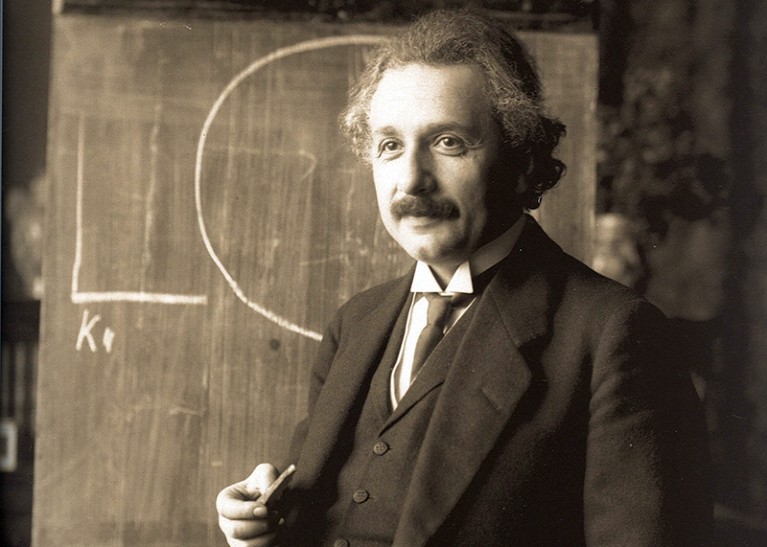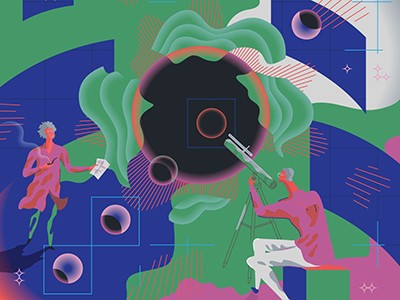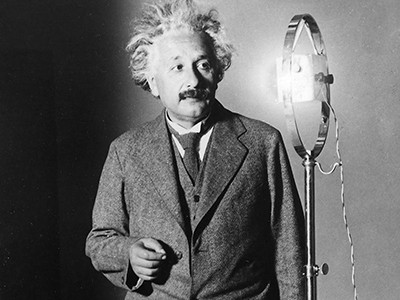
Albert Einstein worked at a university in Prague in 1911–12.Credit: History and Art Collection/Alamy
Einstein in Bohemia Michael D. Gordin Princeton Univ. Press (2020)
Many people skip over the fact that, from early April 1911 to late July 1912, Albert Einstein lived in Prague. “It was, after all, such a short time, and quite early in the physicist’s career,” Michael Gordin explains at the start of Einstein in Bohemia. Historians have variously dismissed those 16 months as an interlude, a sojourn and a detour.
So did I — before I read this improbably good book.
Multiple biographies of Einstein agree that the Prague period is notable for one main reason. Free of the heavy teaching load that had burdened him as an associate professor at the University of Zurich in Switzerland, he focused on developing his general theory of relativity. It was in Prague that Einstein came up with the idea of gravitational lensing, the concept that the pull of stars, planets and other astronomical objects would distort light rays. That idea — tool — is now central to modern astronomy, used to determine, for example, how much dark matter is hovering around clusters of galaxies. Although Einstein had yet to conjure up a dynamical theory of space-time, it was his prediction of gravitational lensing that would demonstrate the theory’s chops in 1919, when physicist Arthur Eddington and his colleagues measured how light from stars in the Hyades cluster was deflected by the gravitational pull of the Sun during a solar eclipse.
Personal impact
At a personal level, gaining the position of professor of theoretical physics at the German University in Prague pushed Einstein into the senior echelons of academia. Just three years before, he had been a patent clerk in Bern. Interestingly, Gordin tells us, he was not the first person to be offered the job: first refusal went to one Gustav Jaumann at the German Technical University in Brno (who remembers him?), who turned it down.
It was also in Prague that Einstein’s marriage to fellow physicist Mileva Marić began to fall apart. She was miserable there: snubbed as a Serbian and resentful at being dragged around for her husband’s career, then left sitting at home while he travelled elsewhere to give talks and collaborate. It was during a trip to Berlin that he began an affair with his cousin Elsa Löwenthal, who eventually became his second wife.
But that is about it. Slim pickings on which to base a whole book, I feared. Yet Gordin does something ingenious. He uses Einstein as a MacGuffin, a device that propels the plot but has little significance to the story he wants to tell. He explodes the narrative out of what he calls the “spacetime interval” of 1911–12 to follow a host of figures who were involved with Einstein in Prague, in some cases very tangentially. In so doing, he careers through the history of ideas as well as the political turmoil of Bohemia (now part of the Czech Republic) during most of the twentieth century, touching on physics, philosophy, nationhood, anti-Semitism and the rise of Prague as a centre of intellectual life.
There are quirky observations, almost worthy of playwright Tom Stoppard. For example, Einstein and writer Franz Kafka probably met at a 1911 cultural soirée in the house of Berta Fanta, a “philosophically ambitious” socialite who held a salon above her husband’s pharmacy in Prague’s Old Town Square.
Social circle
But what really grips are the people. Take Oskar Kraus, a philosopher at the German University. Originally trained in law, he took against Einstein, writing countless articles in philosophy journals unpicking what he saw as egregious internal inconsistencies in relativity. His writing and stance foreshadowed the anti-relativity strand of the Deutsche Physik movement, an eviscerating force in German academia during the rise of the Third Reich. Kraus, who had been born into a Jewish family but converted to Protestantism, was arrested by the Gestapo and ultimately fled to Oxford, UK.
Inevitably, Gordin takes in Ernst Mach, who had been in a post similar to Einstein’s at the German University’s forerunner from 1867 to 1895. Mach had been “the most successful physicist in the university’s history” and played an important role as rector for part of his tenure. But, like Einstein, he had been the second choice for the post. Mach’s ideas shaped the work of important relativists after Einstein, such as Dennis Sciama and Robert Dicke.
Einstein, Eddington and the 1919 eclipse
Another pen portrait is of Einstein’s successor in the post, physicist and philosopher Philipp Frank. His journey through the turbulent Prague of the 1930s serves as spotlight on a place battered by historical forces. During the late 1920s and early 1930s, Frank was part of the Vienna Circle, a hugely influential group of scientists and philosophers that also included philosopher Rudolf Carnap and mathematician Kurt Gödel. In Prague, Frank did much to carry the flame of both Einstein and Mach’s ideas through books and journal articles, publicly sparring with Kraus whenever necessary. In 1938, he had to flee to the United States, where he ended up at Harvard University in Cambridge, Massachusetts, and wrote one of Einstein’s first and most notable biographies.
This is a panoramic view of twentieth-century Bohemia, with a sprinkling of Einstein. But what really carries it through is the beauty and force of Gordin’s prose.


 Did Einstein really say that?
Did Einstein really say that?
 Einstein, Eddington and the 1919 eclipse
Einstein, Eddington and the 1919 eclipse
 The ascent of English
The ascent of English





